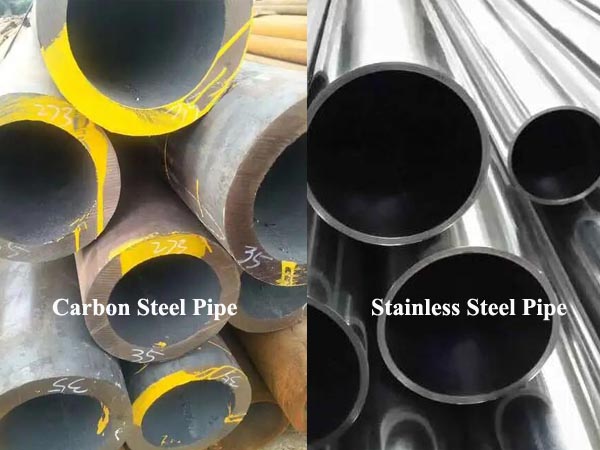
The difference between carbon steel pipe (cs pipe) and stainless steel pipe (ss pipe):
1. Chemical composition
Carbon steel pipe is mainly composed of iron and carbon, of which the carbon content is between 0.06-1.5%, and also contains a small amount of silicon, manganese, sulfur, phosphorus and other elements.
The stainless steel tube is mainly composed of chromium, nickel, molybdenum and other elements, and also contains a small amount of carbon, manganese, silicon and other elements. Therefore, the chemical composition of stainless steel pipes is more complex than that of carbon steel pipes.
2. Corrosion resistance
The main feature of stainless steel pipe is its resistance to corrosion, and its ability to maintain surface brightness and integrity for a long time. Because it contains elements such as chromium, a layer of dense chromium oxide film is formed, which can prevent external substances such as oxygen and water from entering the interior of the metal, thereby achieving the effect of preventing oxidation and corrosion.
Carbon steel pipes, on the other hand, do not have this ability to resist corrosion and often require coating protection to prevent corrosion.

3. Mechanical strength
Carbon steel pipe is a pipe with good mechanical properties, high strength and wear resistance, so it is often used to manufacture parts and components of mechanical equipment.
The mechanical properties of stainless steel pipes are relatively poor, mainly because they contain more alloying elements, which easily lead to problems such as particle precipitation and grain boundary corrosion.
Details of stainless steel pipe:
Stainless steel pipe is unlike other steels in that it resists corrosion. One percent of the chromium in this form of steel, the corrosion resistance of stainless steel pipes is due to the presence of a large amount of chromium in the steel, which forms an invisible, thin and adherent oxide layer that makes the surface passive, in order to form this A passive oxide layer, the steel should contain enough chromium, it needs to be kept in an oxygen-rich environment, the passive layer protects the underlying metal by covering air and water, if scratched the oxide layer will heal automatically, the chromium content of the stainless steel pipe should exceed A certain weight.
In addition to chromium and carbon, stainless steel tubes contain silicon, phosphorus, manganese, sulfur, nickel and molybdenum.
Stainless steel tubes contain a certain weight of carbon. Increasing the carbon content above this value can be made to reduce the corrosion of the steel and reduce the chromium to create a passive oxide layer. According to its crystal structure, stainless steel tubes can be divided into austenite, ferrite, martensite, precipitation hardening, and due to some alloying elements, stainless steel tubes can become non-magnetic.
Details of carbon steel pipe:
Apart from stainless steel pipes, all other carbon steel pipes contain carbon, manganese, silicon and copper, this type of steel can be further divided into low carbon steel pipes, medium carbon steel pipes and high carbon steel pipes according to the carbon content, the corrosion resistance of this alloy Much lower than that of stainless steel pipes. Carbon steel pipe should not be used in more corrosive environments.
Carbon steel pipes are much cheaper than stainless steel pipes. Its main alloying element is relatively expensive chromium is the main alloying element of stainless steel pipes. As the carbon content increases, the shape of this steel becomes harder and harder, which reduces ductility , to change the desired mechanical properties of this steel by heat treatment.
The above is the difference between stainless steel pipes and carbon steel pipes. When selecting pipes, you need to choose according to specific application scenarios and requirements. Customers who have certain requirements for the product should choose stainless steel pipes. Stainless steel pipes have excellent corrosion resistance, anti-aging, anti-explosion, anti-rust, environmental protection, safety, reliability, and can be used for a long time.
Go here to learn more about " Stainless Steel Seamless Pipe VS Carbon Steel Seamless Pipe"
